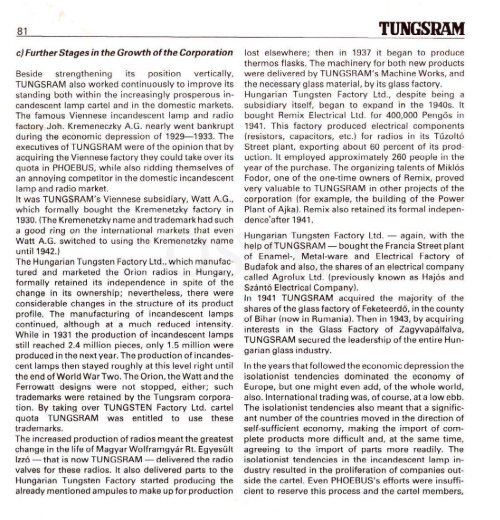THE HISTORY OF TUNGSRAM 1896-1945 - MEK
THE HISTORY OF TUNGSRAM 1896-1945 - MEK
THE HISTORY OF TUNGSRAM 1896-1945 - MEK
- No tags were found...
Create successful ePaper yourself
Turn your PDF publications into a flip-book with our unique Google optimized e-Paper software.
81 <strong>TUNGSRAM</strong>c) Further Stages in the Growth of the CorporationBeside strengthening its position vertically,<strong>TUNGSRAM</strong> also worked continuously to improve itsstanding both within the increasingly prosperous incandescentlamp cartel and in the domestic markets.The famous Viennese incandescent lamp and radiofactory Joh. Kremeneczky A.G. nearly went bankruptduring the economic depression of 1929—1933. Theexecutives of <strong>TUNGSRAM</strong> were of the opinion that byacquiring the Viennese factory they could take over itsquota in PHOEBUS, while also ridding themselves ofan annoying competitor in the domestic incandescentlamp and radio market.It was <strong>TUNGSRAM</strong>'S Viennese subsidiary. Watt A.G.,which formally bought the Kremenetzky factory in1930. (The Kremenetzky name and trademark had sucha good ring on the international markets that evenWatt A.G. switched to using the Kremenetzky nameuntil 1942.)The Hungarian Tungsten Factory Ltd., which manufacturedand marketed the Orion radios in Hungary,formally retained its independence in spite of thechange in its ownership; nevertheless, there wereconsiderable changes in the structure of its productprofile. The manufacturing of incandescent lampscontinued, although at a much reduced intensity.While in 1931 the production of incandescent lampsstill reached 2.4 million pieces, only 1.5 million wereproduced in the next year. The production of incandescentlamps then stayed roughly at this level right untilthe end of World War Two. The Orion, the Watt and theFerrowatt designs were not stopped, either; suchtrademarks were retained by the Tungsram corporation.By taking over TUNGSTEN Factory Ltd. cartelquota <strong>TUNGSRAM</strong> was entitled to use thesetrademarks.The increased production of radios meant the greatestchange in the life of Magyar Wolframgyar Rt. Egyesiiltizzo — that is now <strong>TUNGSRAM</strong> — delivered the radiovalves for these radios. It also delivered parts to theHungarian Tungsten Factory started producing thealready mentioned ampules to make up for productionlost elsewhere; then in 1937 it began to producethermos flasks. The machinery for both new productswere delivered by <strong>TUNGSRAM</strong>'S Machine Works, andthe necessary glass material, by its glass factory.Hungarian Tungsten Factory Ltd., despite being asubsidiary itself, began to expand in the 1940s. Itbought Remix Electrical Ltd. for 400,000 Pengos in1941. This factory produced electrical components(resistors, capacitors, etc.) for radios in its TuzoltoStreet plant, exporting about 60 percent of its production.It employed approximately 260 people in theyear of the purchase. The organizing talents of MiklosFodor, one of the one-time owners of Remix, provedvery valuable to <strong>TUNGSRAM</strong> in other projects of thecorporation (for example, the building of the PowerPlant of Ajka). Remix also retained its formal independence'after1941.Hungarian Tungsten Factory Ltd. — again, with thehelp of <strong>TUNGSRAM</strong> — bought the Francia Street plantof Enamel-, Metal-ware and Electrical Factory ofBudafok and also, the shares of an electrical companycalled Agrolux Ltd. (previously known as Hajos andSzanto Electrical Company).In 1941 <strong>TUNGSRAM</strong> acquired the majority of theshares of the glass factory of Feketeerdo, in the countyof Bihar (now in Rumania). Then in 1943, by acquiringinterests in the Glass Factory of Zagyvapalfalva,<strong>TUNGSRAM</strong> secured the leadership of the entire Hungarianglass industry.In the years that followed the economic depression theisolationist tendencies dominated the economy ofEurope, but one might even add, of the whole world,also. International trading was, of course, at a low ebb.The isolationist tendencies also meant that a significantnumber of the countries moved in the direction ofself-sufficient economy, making the import of completeproducts more difficult and, at the same time,agreeing to the import of parts more readily. Theisolationist tendencies in the incandescent lamp industryresulted in the proliferation of companies outsidethe cartel. Even PHOEBUS's efforts were insufficientto reserve this process and the cartel members.








![Letöltés egy fájlban [4.3 MB - PDF]](https://img.yumpu.com/50159926/1/180x260/letaltacs-egy-fajlban-43-mb-pdf.jpg?quality=85)







